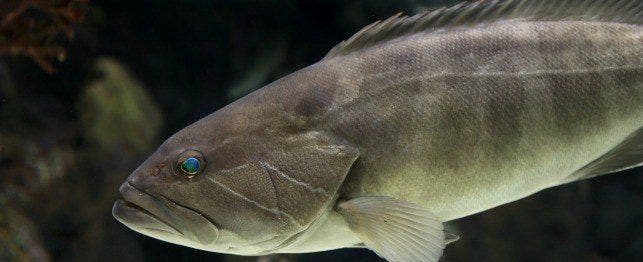
Choosing a Grouper
Groupers can grow to be enormous, reaching lengths of several feet if they are not caught before they reach maturity. The fish are also known as Jewfish in the Caribbean, and it was once common to see these creatures along every healthy reef. Unfortunately, due to fishing pressure, a full-grown healthy grouper is a rare sighting.
Groupers are close relatives of the sea bass, and the two species look very much alike. Both varieties belong to the Serranidae family and the names are often used interchangeably. The Coral Trout, Cephalopholis miniatus, for example, is called a Jewel bass, but is actually considered to be a grouper, so names within this family of fish can get kind of tricky. Should you consider getting a grouper for your tank, identify it by its Latin name to make sure you know exactly what you’re buying.
All groupers are predatory in nature and thus all require some form of meaty foods, preferably live brine shrimp, but chopped squid or clams will also do. They are fairly hardy, although they need good water quality, like just about all other saltwater species. Groupers require a pH of at least 8. Because these species generally hang out close to the bottom and hide in nooks along reefs and rocky shores, they are most comfortable within the normal range of cooler water temperatures, around 75-82 degrees Fahrenheit. They do not require a lot of light, although groupers that come from reefs usually like some light. Many have what seems like an endless appetite, so frequent feeding is usual.
Varieties of Grouper
Several species of grouper are easily kept in larger reef tanks when they are juveniles. Most species grow rapidly, so make sure you know how big your species of choice can get. Keep in mind that even the “small” versions of this species can grow to nearly two feet in length, so they are usually best kept in large tanks (150 or more gallons).
- Panther or polka-dot. Chromileptis altivelis is a beautiful specimen from the tropical Indo-Pacific, beige or brownish in color, with large dark spots from head to tail. It looks a little different from the average grouper in that its snout is somewhat elongated and it moves very gracefully about the tank. This creature is easy to keep but has a voracious appetite and will eat just about any fish or moving invertebrate that will fit in its mouth. The fish are somewhat territorial and solitary but can be kept with larger fish.
- Alexandria. Epinephelus alexandrinus is a species native to the Mediterranean, found mainly near the African coast and in the eastern Atlantic. With a background color of brown to violet with stripes running horizontally along its body, it looks very much like the “common” grouper, E. aeneus. It can grow to 16 inches in length and prefers cooler temperatures of about 71 F. Highly territorial and solitary, it has the unusual ability to pick at and win fights with fish three and four times its own size. Alexandria groupers are not, generally, a good fish to have in a community.
- Clown or bearded. Pogonoperca punctata has an extra piece of skin hanging from its lip. It is a very colorful species, with bright colors, dots and patterns of orange, white and black. It eats just about anything and is very hardy. These fish can grow to about 14 inches in length and don’t mix well with smaller fish. Clown groupers usually hide under crevices and rocks, so you’ll have to provide shelter for it.
- Blue-spotted. Cephalopholis argus is an Indo-Pacific variety that has a blue background with white spots outlined in black. Like the typical grouper, it is hungry just about all the time and eats meaty foods. The fish grows to about 20 inches in length and will eat any smaller fish it can find. Blue-spotted groupers are generally solitary and hang out around rocks waiting for passing prey.
- Six-line. Grammistes sexlineatis is also known as the golden-striped grouper or the gold-line grouper. As the name implies, this fish is striped in an interesting pattern of gold lines on a deep blue or bluish-green background. The species comes from the Indo-Pacific, and it is among the most sought-after grouper – in part because it reaches only a mere 10 inches in size. Like other groupers, it cannot be kept with fish of its own size or smaller. It is quite hardy and long-lived, with some species living as long as 10 years in captivity.